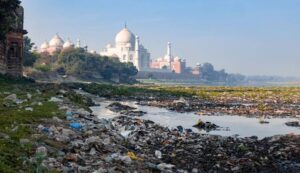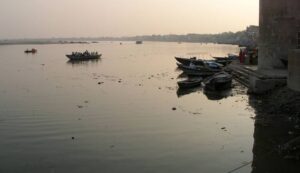The Ganges and Yamuna rivers, considered sacred in Hindu tradition and the epicenter of the Kumbh Mela festival, present alarming levels of fecal contamination, exceeding by more than ten times the limit recommended by environmental authorities. This was warned by the Central Pollution Control Board (CPCB) in a report addressed to India’s Green Court, where the serious water pollution in the country is being debated.
The CPCB warned that the water quality in these rivers does not meet the minimum standards for recreational activities such as bathing, especially due to the presence of fecal coliforms in worrying concentrations. According to the organization, pollution was detected in all monitored areas throughout several days of the festival.
The increase in pollution is partly attributed to the massive ritual baths performed by pilgrims since the beginning of the Kumbh Mela on January 13 in Prayagraj, Uttar Pradesh state. This religious celebration, considered the largest human gathering on the planet, is expected to bring together about 450 million devotees until its conclusion on February 26.
According to the CPCB report, in some points of the rivers up to 33,000 units of fecal coliforms per 100 milliliters of water were recorded, when the desired limit should not exceed 2,500 units. Among the millions of attendees who immersed themselves in these waters are prominent figures such as the Prime Minister of India, Narendra Modi, members of his cabinet, businessmen, and international celebrities like Laurene Powell Jobs, widow of Steve Jobs.

A river marked by spirituality and severe contamination
Prayagraj is a place of great spiritual significance, as the Ganges, Yamuna, and the mythological Sarasvati converge at this point. Pilgrims flock to these waters with the belief that the ritual bath purifies their sins. To date, more than 540 million immersions in the rivers have been registered.
The report also points out that, near Prayagraj, seven wastewater treatment plants operate discharging their waste into the Ganges and Yamuna, contributing to water pollution. Despite warnings about water quality, many devotees continue to collect water from the rivers in jugs or bottles to take it to their homes and use it in religious ceremonies.

Why are the Ganges and Yamuna rivers so important?
The Ganges and Yamuna rivers are important due to their cultural, religious, and as a water source for the community.
Ganges
It is the holiest river in Hinduism, as it is believed to connect with heaven and is the incarnation of the goddess Ganga. For this reason, millions of people bathe in it to honor their ancestors.
It is also the most important river resource in India, as it flows into the Bay of Bengal forming the Ganges Delta, the largest delta in the world, and its river basin hosts a large amount of wildlife.
Yamuna
It is one of the seven sacred rivers of India, as Hindus consider it the second holiest river in India, after the Ganges. According to their beliefs, the god Krishna spent his childhood in Vrindavan, on the banks of this river.
In general, the rivers were fundamental for the development of civilizations, providing drinking water, food, a means of transportation and communication. During rainy seasons, they flooded the lands making them fertile. However, today, these waters suffer the consequences of the serious pollution they face.
Have you visited our YouTube channel yet? Subscribe now!

